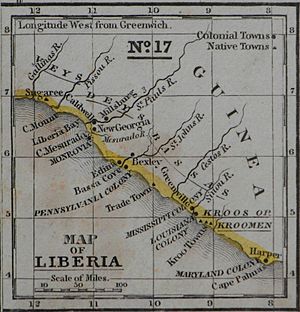Jeremiah Chamberlain facts for kids
Quick facts for kids
Jeremiah Chamberlain
|
|
|---|---|
| Born | January 5, 1794 |
| Died | September 5, 1851 |
| Education | Dickinson College Princeton Theological Seminary |
| Occupation | Preacher, educator |
| Spouse(s) | Rebecca (Blain) Chamberlain |
| Children | Susan Ann Chamberlain Sarah Matilda Chamberlain Isabella (Chamberlain) Hyland Rebecca Clarissa (Chamberlain) Sleeper |
| Relatives | William S. Hyland (son-in-law) Fabius H. Sleeper (son-in-law) |
Jeremiah Chamberlain (1794–1851) was an American minister, teacher, and college leader. He studied at Dickinson College and Princeton Theological Seminary. From 1822 to 1825, he was the president of Centre College in Kentucky.
He also helped start Oakland College in Mississippi. He led this college from 1830 until he passed away in 1851. Chamberlain believed that slavery should end. He helped create the Mississippi Colonization Society. This group worked to move free people of color from Mississippi to Liberia in West Africa.
In 1850, Chamberlain still owned three enslaved people. The next year, he was killed during an argument with a planter who supported slavery.
Contents
Jeremiah Chamberlain's Life Story
Growing Up in Pennsylvania
Jeremiah Chamberlain was born on January 5, 1794, in Pennsylvania. His father, James Chamberlain, was a colonel in the American Revolutionary War (1775–1783). Jeremiah grew up on a farm near Gettysburg, Pennsylvania. He went to school in York County. In 1814, he graduated from Dickinson College in Carlisle, Pennsylvania.
Chamberlain was part of the first class to graduate from Princeton Theological Seminary in Princeton, New Jersey, in 1817. After that, he went back to Pennsylvania. There, he joined the Carlisle Presbyterian Ministry.
His Career as an Educator
In 1817, Chamberlain worked as a Presbyterian missionary in the Southwest. The next year, he became a Presbyterian minister in Bedford, Pennsylvania.
From 1822 to 1825, he was the president of Centre College in Danville, Kentucky. The college was having serious money problems. To help, Chamberlain worked to give control of the college to the Presbyterian Church. This happened in 1824. The church then chose the college's leaders and managed its money.
Chamberlain later moved South. He became president of the College of Louisiana in Jackson, Louisiana, from 1826 to 1828.
In 1828, he tried to start a new Presbyterian school in Mississippi. At the same time, he served as a minister at Bethel Presbyterian Church in Alcorn.
Two years later, in 1830, Chamberlain became the president of Oakland College. This college was near Rodney, Mississippi. The college closed in 1861 because of the American Civil War. Its students left to fight in the war. After the war, the college never fully recovered. In 1870, its leaders sold the land to the state. The state then created Alcorn State University there. This was the first black land grant school in the country. The old Oakland Memorial Chapel, built in 1838, is still on its campus.
Oakland College reopened in 1879 as a school for boys. It was in Port Gibson, nearby. It was named Chamberlain-Hunt Academy (CHA) after Jeremiah Chamberlain and Mr. David Hunt. Hunt was a local planter and a very kind supporter of Oakland. CHA was a school that prepared students for college until it closed in 2014.
Chamberlain continued to support the Union. He was also against slavery. In the 1830s, he worked with planters like Isaac Ross, Edward McGehee, Stephen Duncan, and John Ker. Together, they started the Mississippi Colonization Society. This group wanted to send freed enslaved people and other free Black people to live in Liberia in Africa. This group was like the American Colonization Society. But it focused on freed people in Mississippi, where most people were enslaved. The planters thought that free Black people made slave society unstable. So, they wanted them to leave. Their colony was called Mississippi-in-Africa.
In 1850, records show that Chamberlain still owned three young enslaved people. They were 24, 17, and 15 years old. They likely worked in his family's home.
Jeremiah Chamberlain's Family
Jeremiah Chamberlain married Rebecca Blain (1792–1836). They had four daughters:
- Susan Ann Chamberlain (1820–1834).
- Sarah Matilda Chamberlain (1830–1833).
- Isabella Chamberlain (1825–1846). She married William S. Hyland in 1844.
- Rebecca Clarissa Chamberlain (1827–1857). She married Fabius H. Sleeper in 1851.
His Death
On September 5, 1851, Jeremiah Chamberlain was killed. He had an argument with George A. Briscoe, a planter who supported slavery. Chamberlain had spoken out against slavery. He was buried in a cemetery on the Oakland College campus. A week after the attack, Briscoe, his killer, also died. Chamberlain's grave and a memorial stone are still on the campus of Alcorn State University today. His wife and four daughters were later buried next to him.
Jeremiah Chamberlain's Legacy
In 1879, the Chamberlain-Hunt Academy in Port Gibson, Mississippi, was named after him. It was also named after David Hunt (1779–1861). Hunt was a rich planter and gave a lot of money to good causes.
Chamberlain's important papers are kept safe at the Mississippi Department of Archives and History in Jackson, Mississippi.


